
Qatar is a nation situated eastwards of the Arabian peninsula of which it is considered a part of. Upwards of 30 reptile species [1] have been recorded as living in the country. Most of the country is arid, with a presence of dunes in the far south, close to neighbouring Saudi Arabia.[2]
Qatar possesses three forms of environment in which reptiles can be observed - Arid, urban, and marine. The country is relatively even in height and low, as its highest natural point is only 103 metres above sea level. [3]
There are several species that are considered dangerous,[4] thus an exclamation mark (!) will be used to highlight a species that may cause harm to humans, and a skull ( ![]() ) if the animal is responsible for at least one human fatality
) if the animal is responsible for at least one human fatality
Sea turtles
Order: Testudines Family: Cheloniidae
Cheloniidae is a family of sea turtles with cosmopolitan distribution. The family contains seven species in five genera. Two of these species have been recorded in Qatar.[5][6]
| Common name | Binomial name | Carapace length | Mass | Global status | Global trend | Distribution | Image |
|---|---|---|---|---|---|---|---|
| Green turtle | Chelonia mydas | 150 cm (59 in) | 160 kg (350 lb) | Endangered | Primarily aquatic. May be found at coasts or islands where it comes to nest. | _(6133097542).jpg.webp) | |
| Hawksbill turtle | Eretmochelys imbricata) | 100 cm (39 in) | 80 kg (180 lb) | Critically endangered | Primarily aquatic, and most likely to nest in Fuwayrit given its soft sand | .jpg.webp) | |
Leatherback turtle
Order: Testudines Family: Dermochelyidae
Dermochelyidae is a family of turtles which historically had 7 species. Currently, only one species still exists - the leatherback turtle. It is the largest member of its order, and the third-largest reptile in terms of average mass. .[7] Though uncommon, it has been reported in the country. [8]
| Common name | Binomial name | Carapace length | Mass | Global status | Trend | Distribution | Image |
|---|---|---|---|---|---|---|---|
| Leatherback turtle | Dermochelys coriacea | 230 cm (91 in) | 600 kg (1,300 lb) | Vulnerable | Primarily aquatic, rare to see in the country. |  | |
Geckos
Order: Squamata Family: Gekkonidae
Gekkonidae is a large family of cosmopolitan lizards. It is a remarkably diverse family with upwards of a thousand species.[9] Bearing specially-designed pads on their toes, geckos are granted effective adhesion to several surfaces. Vernacularly known as “بريعصي [10]", there are at least 10 species in Qatar.
| Common name | Binomial name | Length | Global status | Trend | Habitat and distribution | Image |
|---|---|---|---|---|---|---|
| Big-headed gecko | Stenodactylus slevini | 10 cm (3.9 in) | Least concern | A nocturnal lizard. It inhabits compact dry environments with shrubs. | .jpg.webp) | |
| Northern house gecko | Hemidactylus flaviviridis | 15 cm (5.9 in) | Least concern | This nocturnal lizard favours urban environments, inhabiting homes as well as abandoned ruins where it may find insect prey. Individuals can be found hiding in crevices or under surfaces. | 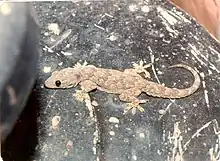 | |
| Baluch stone gecko | Bunopus tuberculatus | 10 cm (3.9 in) | Least concern | Like other nocturnal lizard, the stone gecko inhabits arid and rural regions. During the day, it prefers to hide under rocks and is active at night, searching the habitat for food. | 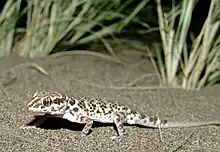 | |
| Keeled rock gecko | Cyrtopodion scabrum | 10 cm (3.9 in) | Least concern | Prefers to hide out in uninhabited towns and buildings during the day. | 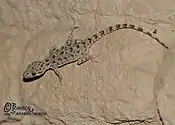 | |
| Arabian sand gecko | Trigonodactylus arabicus | 12 cm (4.7 in) | Least concern | Hides in burrows during the day. It is strictly ground-dwelling and may be found in open deserts or at dunes in the south and Doha during nighttime | ||
| Gulf sand gecko | Pseudoceramodactylus khobarensis | 12 cm (4.7 in) | Least concern | Found in mainland Qatar as well as the offshore islands in which it was first observed. It prefers soil and soft sand and may be encountered in beaches. | ||
| Heyden's gecko | Hemidactylus robustus | 10 cm (3.9 in) | Least concern | Found on the mainland, it tolerates a wide variety of habitat. Hiding during the day, it can be found in fields, sparse semi-deserts and urban environments. | ||
| Persian leaf-toed gecko | Hemidactylus persicus | 10 cm (3.9 in) | Least concern | Endemic to Halul island, has not been found in the mainland. Found elsewhere in the Persian Gulf | _Figure_3_(cropped).jpg.webp) | |
Agamids
Order: Squamata Family: Agamidae
Agamidae is a large family of Old World lizards distributed across a multitude of habitats. Globally, the family contains approximately 350 species [11]
| Common name | Binomial name | Length | Global status | Trend | Habitat and distribution | Image |
|---|---|---|---|---|---|---|
| Jayakar's agama | Agama flavimaculata | 25 cm (9.8 in) | Least concern | Diurnal and found in open rocky areas. In breeding season, males acquire extreme colour changes as the head becomes blue and the tail red. |  | |
| Sinai agama | Pseudotrapelus sinaitus | 25 cm (9.8 in) | Least concern | Similar to the Jayakar's agama in both behaviour and shape. | 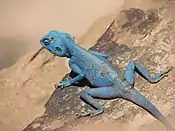 | |
| Toad-headed agama | Phrynocephalus arabicus | 20 cm (7.9 in) | Least concern | This species is diurnal and prefers soft sand, as is found in the dunes at Doha. |  | |
| Giant spike-tailed agama | Uromastyx aegyptia | 75 cm (30 in) | Vulnerable | Prefers open desert throughout the country, particularly arid regions with dense sand, allowing it to burrow |  | |
Skinks
Order: Squamata Family: Scincidae
Scincidae is a family of lizards, commonly known as skinks. It is one of the biggest families in the entire order, bearing well over 1,500 species .[12] They are primarily terrestrial and insectivorous
| Common name | Binomial name | Length | Global status | Trend | Habitat and distribution | Image |
|---|---|---|---|---|---|---|
| Eastern sandfish | Scincus mitranus | 20 cm (7.9 in) | Least concern | A diurnal lizard, this species is found in the south of the countries exclusively inhabiting dunes, as it dives under the sand when a threat is perceived. |  | |
| Ocellated skink | Chalcides ocellatus | 26 cm (10 in) | Least concern | Inhabits overgrowth and meadow-like environments in Qatar. May be found in parks as a result. |  | |
| Golden grass-skink | Heremites septemtaeniatus | 18 cm (7.1 in) | Least concern | Possibly introduced, this skink exclusively inhabits man-made habitats like gardens and lawns in the country | ||
Monitors
Order: Squamata Family: Varanidae
Varanidae is a family of highly predatory and venomous lizards in the old world. There are about 45 species,[13] one of which is found in Qatar.
| Common name | Binomial name | Length | Global status | Trend | Habitat and distribution | Image |
|---|---|---|---|---|---|---|
| Desert monitor (!) | Varanus griseus | 110 cm (43 in) | Least concern | Once common throughout open deserts in the country, this is now a scarce species. It prefers vast plains where it can spot and chase down prey. | _(14781757251).jpg.webp) | |
True Lizards
Order: Squamata Family: Lacertidae
Lacertidae is a family diverse family of lizards, of which the entire suborder derived its name [14]
| Common name | Binomial name | Length | Global status | Trend | Habitat and distribution | Image |
|---|---|---|---|---|---|---|
| Fringe-toed sand lizard | Acanthodactylus boskianus | 15 cm (5.9 in) | Least concern | Found in coastal plains, oases and cultivated regions. Diurnal. | _juvenile.jpg.webp) | |
| Nidua | Acanthodactylus scutellatus | 15 cm (5.9 in) | Least concern | Prefers open desert and shrubbery. |  | |
| Short-nosed desert lizard | Eremias brevirostris | 15 cm (5.9 in) | Least concern | Found nationwide in scrubs, as well as wide sandy areas. | ||
| Arnold's fringe-fingered lizard | Acanthodactylus opheodurus | 18 cm (7.1 in) | Least concern | Inhabits arid desert with shrubbery, particularly because females deposit eggs in holes dug under bushes. | 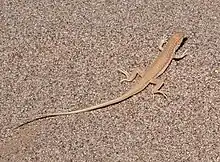 | |
| Schmidt's fringe-fingered lizard | Acanthodactylus opheodurus | 18 cm (7.1 in) | Least concern | Found in more sandy areas, especially dunes near the capital Doha | 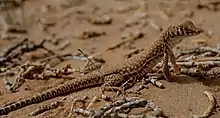 | |
| Hadramout sand lizard | Mesalina adramitana | 12 cm (4.7 in) | Least concern | N/A | Found in more sandy areas, especially dunes near the capital Doha | 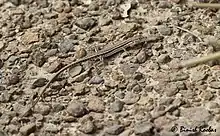 |
Palaearctic worm-lizard
Order: Squamata Family: Trogonophidae
Trogonophidae is a family of amphisbaenians. They do not possess any limbs and engage in a primarily underground lifestyle. [15]
| Common name | Binomial name | Length | Global status | Trend | Habitat and distribution | Image |
|---|---|---|---|---|---|---|
| Arabian worm-lizard | Diplometopon zarudnyi | 30 cm (12 in) | Least concern | Inhabiting soft soils as well as caves, thus subterranean animal is not common in the country due to its adapted habitat. |  | |
Colubrids
Order: Squamata Family: Colubridae
Colubridae is the largest family of snakes, with over 230 species.[16] They are primarily constrictors, however there are some species that possess venom.
| Common name | Binomial name | Length | Global status | Trend | Habitat and distribution | Image |
|---|---|---|---|---|---|---|
| Glossy-bellied racer | Platyceps ventromaculatus | 120 cm (47 in) | Least concern | This non-venomous snake prefers both desert and man-made environments especially to hide. |  | |
| Afro-Asian sand snake | Psammophis schokari | 100 cm (39 in) | Least concern | ? | Mildly venomous, or prefers areas with vegetation and avoids barren desert. | _(14784931025).jpg.webp) |
| False cobra | Malpolon moilensis | 170 cm (67 in) | Least concern | Found further from urban environments, preferring to inhabit open desert and barren outcrops. |  | |
| Crowned leaf-nosed snake | Lytorhinchus diadema | 30 cm (12 in) | Least concern | This small non-venomous snake lives all across the country, preferring soft sand and gravel plains. |  | |
| Diadem ratsnake | Spalerosophis diadema | 170 cm (67 in) | Least concern | Mildly venomous snake, found in sandy habitats and open desert in Qatar, as well as savannahs elsewhere. | _(18545191480).jpg.webp) | |
| Dwarf crowned racer | Eirenis coronella | 30 cm (12 in) | Least concern | A non venomous snake that inhabits temperate environments. In Qatar it prefers man-made agricultural habitats. | 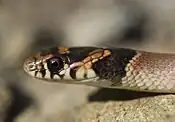 | |
Sea snakes
Order: Squamata Family: Hydrophiinae
Hydrophiinae is a family of snakes, most of which are highly venomous.[17] They inhabit coastal environments and are specially adapted for an aquatic lifestyle
| Common name | Binomial name | Length | Global status | Trend | Habitat and distribution | Image |
|---|---|---|---|---|---|---|
| Blue-banded sea snake | Hydrophis cyanocinctus | 180 cm (71 in) | Least concern | ? | A highly venomous snake that inhabits shallow waters in the indo-pacific. | .jpg.webp) |
| Persian Gulf sea snake | Hydrophis lapemoides | 95 cm (37 in) | Least concern | Common in the Indian Ocean. May be found in coastal waters and reefs | ||
| Yellow banded sea-snake (!) [19] | Pelamis pelaturus | 2.75 m (9 ft 0 in) | Least concern | ? | Perhaps the largest sea snake, it inhabits shallow water in the Indo-pacific. | |
| Yellow-bellied sea snake | Pelamis platurus | 65 cm (26 in) | Least concern | Very flattened and adaptable when it comes to marine environments; may be found in deeper water. |  | |
Vipers
Order: Squamata Family: Viperidae
Viperidae is a family of highly venomous snakes found throughout the majority of the mainland continents. It is a relatively diverse family with more than 200 species.[21]
| Common name | Binomial name | Length | Global status | Trend | Habitat and distribution | Image |
|---|---|---|---|---|---|---|
| Arabian horned viper (!) [22] | Cerastes gasperettii | 75 cm (30 in) | Least concern | Distributed through the peninsula, this viper prefers vegetated habitats with soft sand in which it partially buries itself. | .jpg.webp) | |
| Saw-scaled viper | Echis carinatus | 50 cm (20 in) | Least concern | Found in man-made habitats as well as deserts from the Indian subcontinent to the Arabian peninsula |  | |
Boas
Order: Squamata Family: Boidae
Boidae is a family of nonvenomous constricting snakes that inhabit tropical and semi-tropical regions. There are over 40 [24] species in the family
| Common name | Binomial name | Length | Global status | Trend | Habitat and distribution | Image |
|---|---|---|---|---|---|---|
| Arabian sand boa | Eryx jayakari | 40 cm (16 in) | Least concern | Widespread across the peninsula as well as Iran. It hides under deep sand in the day and is only active during darkness |  | |
Elapids
Order: Squamata Family: Elapidae
Elapidae is a family of highly venomous snakes with non-retractable fangs. It includes the well-known cobras. There are over 300 [25] species in the family
| Common name | Binomial name | Length | Global status | Trend | Habitat and distribution | Image |
|---|---|---|---|---|---|---|
| Desert black snake | Walterinnesia morgani | 60 cm (24 in) | Least concern | Exclusively nocturnal, this species inhabits east Arabia. It prefers vegetated sandy habitats |  | |
References
- ↑ "species".
- ↑ "South".
- ↑ "height". Archived from the original on 21 June 2012.
- ↑ "threat".
- ↑ "sea turtle" (PDF).
- ↑ "Fuwairit".
- ↑ "Magnitude".
- ↑ "Qatar leatherback".
- ↑ "Geckos".
- ↑ "Bre3sy".
- ↑ "Species agamidae".
- ↑ "Skink species".
- ↑ "Species Varanidae".
- ↑ "Lizard names".
- ↑ "Trogonophidae".
- ↑ "Colubridae species".
- ↑ "Hydrophiinae venom".
- ↑ "BB seasnake venom".
- ↑ "YB seasnake venom".
- ↑ "Yellow-bellied Sea-Snake (Hydrophis platurus)". www.reptilesofecuador.com.
- ↑ "YB seasnake venom".
- ↑ "AH viper venom".
- ↑ "SS viper venom".
- ↑ "Boidae species".
- ↑ "Elapidae species".
- ↑ "Walterinnesia morgani death".